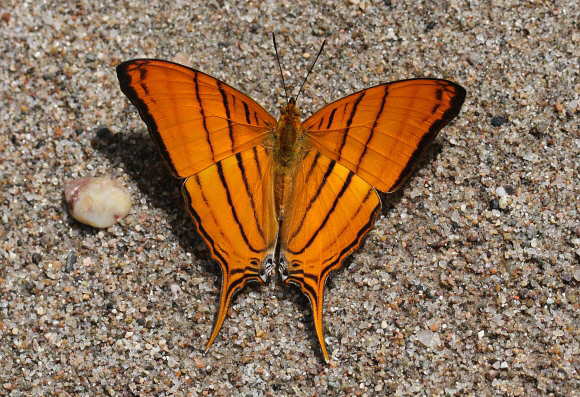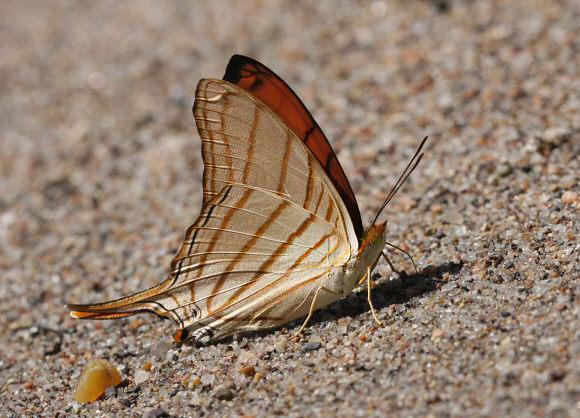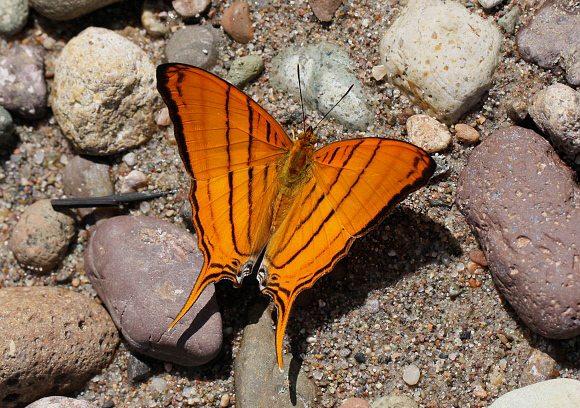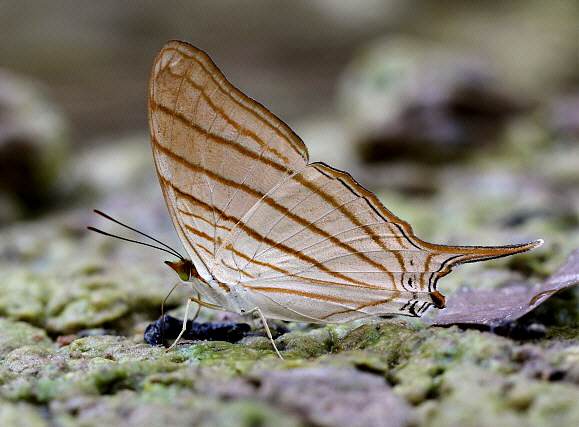 Marpesia berania berania, male, Rio Pindayo, Peru – Adrian Hoskins
Marpesia berania berania, male, Rio Pindayo, Peru – Adrian Hoskins
Introduction
The genus Marpesia is confined largely to the neotropical region, but is closely allied to the Mapwing and Maplet butterflies ( Cyrestis & Chersonesia ) of the Oriental region.
Daggerwings are similar in wing shape to Swordtails and Swallowtails ( Papilionidae ), but the latter have 6 legs whereas Marpesia and all other Nymphalidae genera have only 4 legs. Another feature to look for is the antennae. In all Papilionids these are recurved at the tip, but in Marpesia they are straight. In total there are 17 Marpesia species, all with the same wing shape as berania except for petreus which has 2 tails on each hindwing and a deeply scalloped outer margin to it’s forewing.
 Marpesia berania berania, male, Catarata Bayoz, La Merced, Peru – Adrian Hoskins
Marpesia berania berania, male, Catarata Bayoz, La Merced, Peru – Adrian Hoskins
There are 17 Marpesia species, all with the same characteristic wing shape as berania, except for petreus, which has 2 tails on each hindwing, and a deeply scalloped outer margin to it’s forewing.
Marpesia berania is a common and widespread species found from Honduras to Peru.
 Marpesia berania berania, male, Rio Pindayo, Peru – Adrian Hoskins
Marpesia berania berania, male, Rio Pindayo, Peru – Adrian Hoskins
Habitats
This species occurs at elevations between sea level and about 1800m, but is encountered more frequently below 1000m. It is found in forested habitats, and is often seen on river sandbanks, and in forest clearings and other semi-open habitats.
 Marpesia berania berania, Rio Pindayo, Peru – Adrian Hoskins
Marpesia berania berania, Rio Pindayo, Peru – Adrian Hoskins
Lifecycle
I have no data relating to berania, but the following characteristics are applicable in general to the genus Marpesia : The eggs are white or yellowish, and laid singly on the foliage of trees and shrubs in the family Moraceae – including Ficus, Chlorophora, Brosimum and Artocarpus. The fully grown larvae are very colourful, typically marked with red or yellow spots and stripes. There is a single row of unbranched, recurved spines along the back, and the head is adorned with a pair of very long wavy spines. They feed diurnally and rest on the upper surface of leaves. The pupae are typically pale in colour, marked with blackish spots or blotches, and have wiry filaments projecting from the back of the abdomen and from the head.
Adult behaviour
Mud-puddling males are usually encountered singly, although small aggregations of half a dozen or so are sometimes found imbibing mineralised moisture on river beaches or at the edges of puddles. In very hot conditions, when feeding or at rest on foliage, the butterflies hold their wings erect; but this is a species which normally basks with wings fully outspread. Females spend most of their lives in the forest canopy. They nectar at Cordia and Croton but are rarely seen.
This species forms gregarious nocturnal roosts in which between 20-60 adults of both sexes gather and hang in dense clusters from tree branches. Individual roosting sites are sometimes maintained for several months. Marking studies have shown that some individuals remain at the roost for up to a week while others are continually active and return each night to the same roost. These studies have also shown that some individuals may live for up to 5 months.

Marpesia berania berania, Satipo, Peru – Adrian Hoskins
